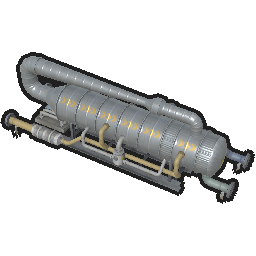Difference between revisions of "Thermal Desalinator"
m (Footer Infobox) |
(Update recipes and a infobox machine for version 0.5.1b) |
||
| Line 10: | Line 10: | ||
}} | }} | ||
| Workers = 4 | | Workers = 4 | ||
| Electricity = | | Electricity = 400 KW | ||
| Maintenance = 2 | | Maintenance = 2 | ||
| Footprint = 11x4 | | Footprint = 11x4 | ||
| Line 18: | Line 18: | ||
| Variants = | | Variants = | ||
}} | }} | ||
The '''Thermal Desalinator''' is a machine which converts {{infoicon|Seawater}} and either {{infoicon|Steam Hi}}, {{infoicon|Steam Lo}}, or {{infoicon|Steam Depleted}} into {{infoicon|Water}} and {{infoicon|Brine}}. Due to the high fuel cost for making steam, [[Groundwater Pump]] is vastly more efficient if there is sufficient rainfall to replenish groundwater aquifers. | The '''Thermal Desalinator''' is a machine which converts {{infoicon|Seawater}} and either {{infoicon|Steam (Super)}}, {{infoicon|Steam Hi}}, {{infoicon|Steam Lo}}, or {{infoicon|Steam Depleted}} into {{infoicon|Water}} and {{infoicon|Brine}}. Due to the high fuel cost for making steam, [[Groundwater Pump]] is vastly more efficient if there is sufficient rainfall to replenish groundwater aquifers. | ||
The Brine byproduct can be utilized in [[Electrolyzer]]s to create {{infoicon|Chlorine}} to treat {{infoicon|Waste Water}} or in fed into [[Wastewater Treatment]] machines to convert {{infoicon|Toxic Slurry}} into {{infoicon|Slag}}. The [[Evaporation Pond]] and [[Evaporation Pond (Heated)]] can also process Brine into Salt. However due to the high fuel cost for making steam, the production of Salt from Seawater with the Evaporation Pond is several times more energy efficient. | The Brine byproduct can be utilized in [[Electrolyzer]]s to create {{infoicon|Chlorine}} to treat {{infoicon|Waste Water}} or in fed into [[Wastewater Treatment]] machines to convert {{infoicon|Toxic Slurry}} into {{infoicon|Slag}}. The [[Evaporation Pond]] and [[Evaporation Pond (Heated)]] can also process Brine into Salt. However due to the high fuel cost for making steam, the production of Salt from Seawater with the Evaporation Pond is several times more energy efficient. | ||
{{recipe define | {{recipe define | ||
| Input1Name = Seawater | | Input1Name = Seawater | ||
| Input1Qty = 10 | | Input1Qty = 18 | ||
| Input2Name = Steam (Super) | |||
| Input2Qty = 1 | |||
| Time = 10 | |||
| Output1Name = Water | |||
| Output1Qty = 12 | |||
| Output2Name = Brine | |||
| Output2Qty = 7 | |||
}}{{recipe define | |||
| Input1Name = Seawater | |||
| Input1Qty = 18 | |||
| Input2Name = Steam Hi | | Input2Name = Steam Hi | ||
| Input2Qty = 2 | | Input2Qty = 2 | ||
| Time = 10 | | Time = 10 | ||
| Output1Name = Water | | Output1Name = Water | ||
| Output1Qty = | | Output1Qty = 13 | ||
| Output2Name = Brine | | Output2Name = Brine | ||
| Output2Qty = | | Output2Qty = 7 | ||
}}{{recipe define | }}{{recipe define | ||
| Input1Name = Seawater | | Input1Name = Seawater | ||
| Input1Qty = | | Input1Qty = 12 | ||
| Input2Name = Steam Lo | | Input2Name = Steam Lo | ||
| Input2Qty = 4 | | Input2Qty = 4 | ||
| Time = | | Time = 10 | ||
| Output1Name = Water | | Output1Name = Water | ||
| Output1Qty = | | Output1Qty = 12 | ||
| Output2Name = Brine | | Output2Name = Brine | ||
| Output2Qty = | | Output2Qty = 4 | ||
}}{{recipe define | }}{{recipe define | ||
| Input1Name = Seawater | | Input1Name = Seawater | ||
| Input1Qty = | | Input1Qty = 5 | ||
| Input2Name = Steam Depleted | | Input2Name = Steam Depleted | ||
| Input2Qty = 8 | | Input2Qty = 8 | ||
| Time = | | Time = 20 | ||
| Output1Name = Water | | Output1Name = Water | ||
| Output1Qty = | | Output1Qty = 11 | ||
| Output2Name = Brine | | Output2Name = Brine | ||
| Output2Qty = 2 | | Output2Qty = 2 | ||
}}{{Footer Infobox}} | }}{{Footer Infobox}} | ||
Revision as of 11:51, 16 May 2023

| Construction | |
| Workers | |
| Electricity | |
| Maintenance | |
| Footprint | 11x4 |
| Required Research | Thermal Desalination |
| Boost by Unity | Available |
| Designation | Water Extraction & Processing |
The Thermal Desalinator is a machine which converts Seawater and either Steam (Super), Steam (High), Steam (Low), or Steam Depleted into Water and Brine. Due to the high fuel cost for making steam, Groundwater Pump is vastly more efficient if there is sufficient rainfall to replenish groundwater aquifers.
The Brine byproduct can be utilized in Electrolyzers to create Chlorine to treat Waste Water or in fed into Wastewater Treatment machines to convert Toxic Slurry into Slag. The Evaporation Pond and Evaporation Pond (Heated) can also process Brine into Salt. However due to the high fuel cost for making steam, the production of Salt from Seawater with the Evaporation Pond is several times more energy efficient.
Recipes
Below are all the recipes, which this building is capable of producing. Note, that some of them may be locked behind Research, and not immediately available in your game.
This article invokes definition of game's source data (either directly, or with one or several template invokes). Editing it will result in updates to some of the stored tables, which in turn updates automated data lists. See more. If you've found incorrect data, related to this article's topic, it is a good place to start searching for definitions, requiring updates. |
| |
| |
| Planned or Proposed | |
| * Only available in the Supporter Edition | |